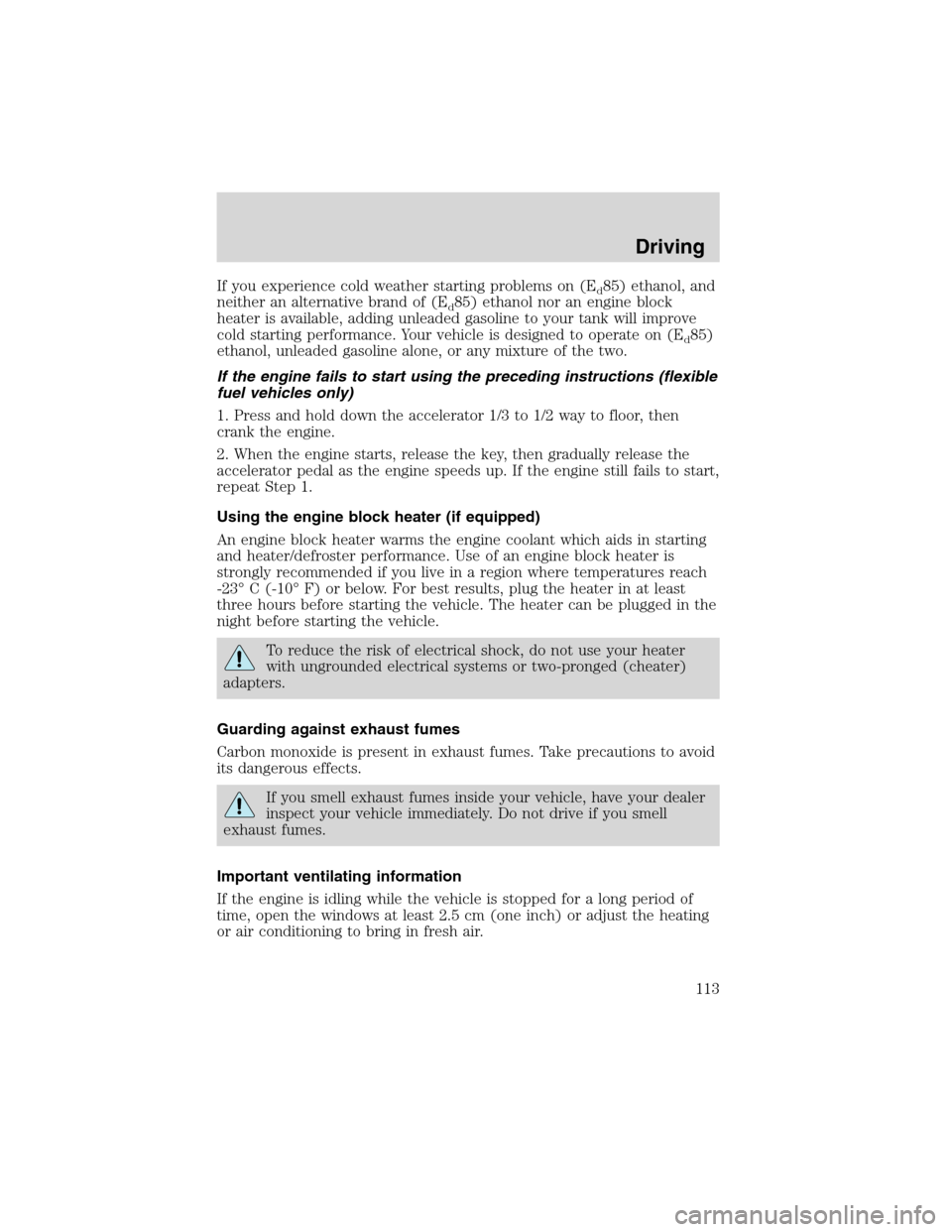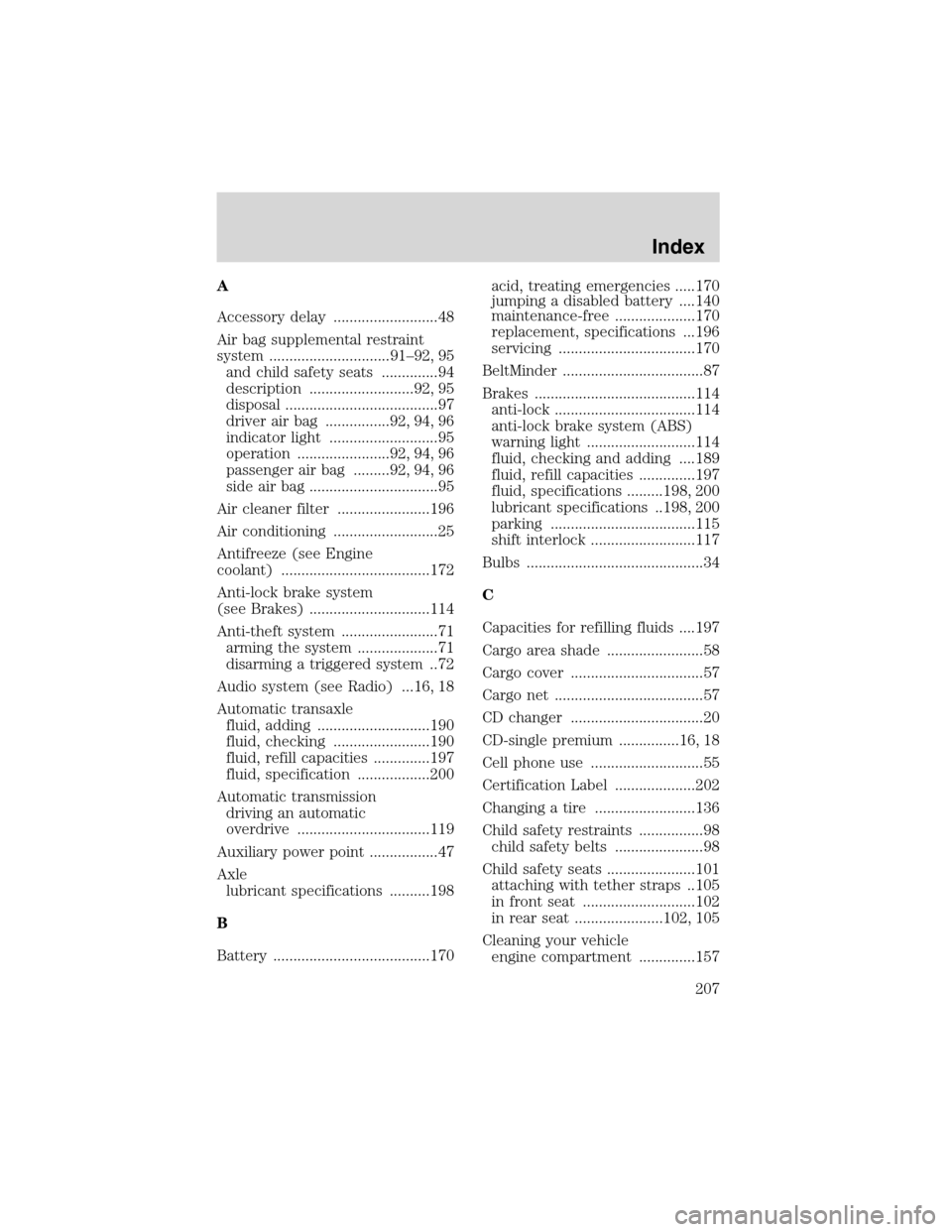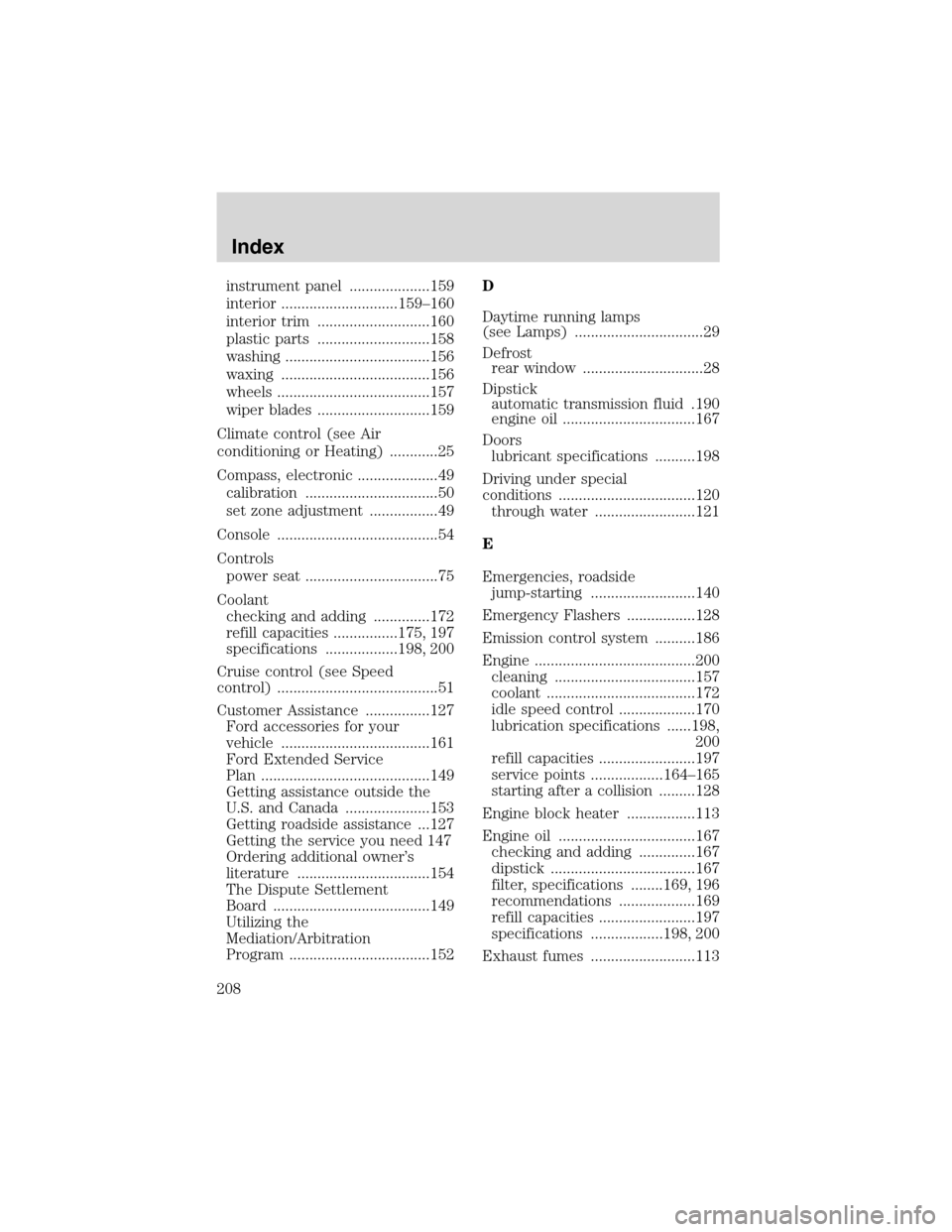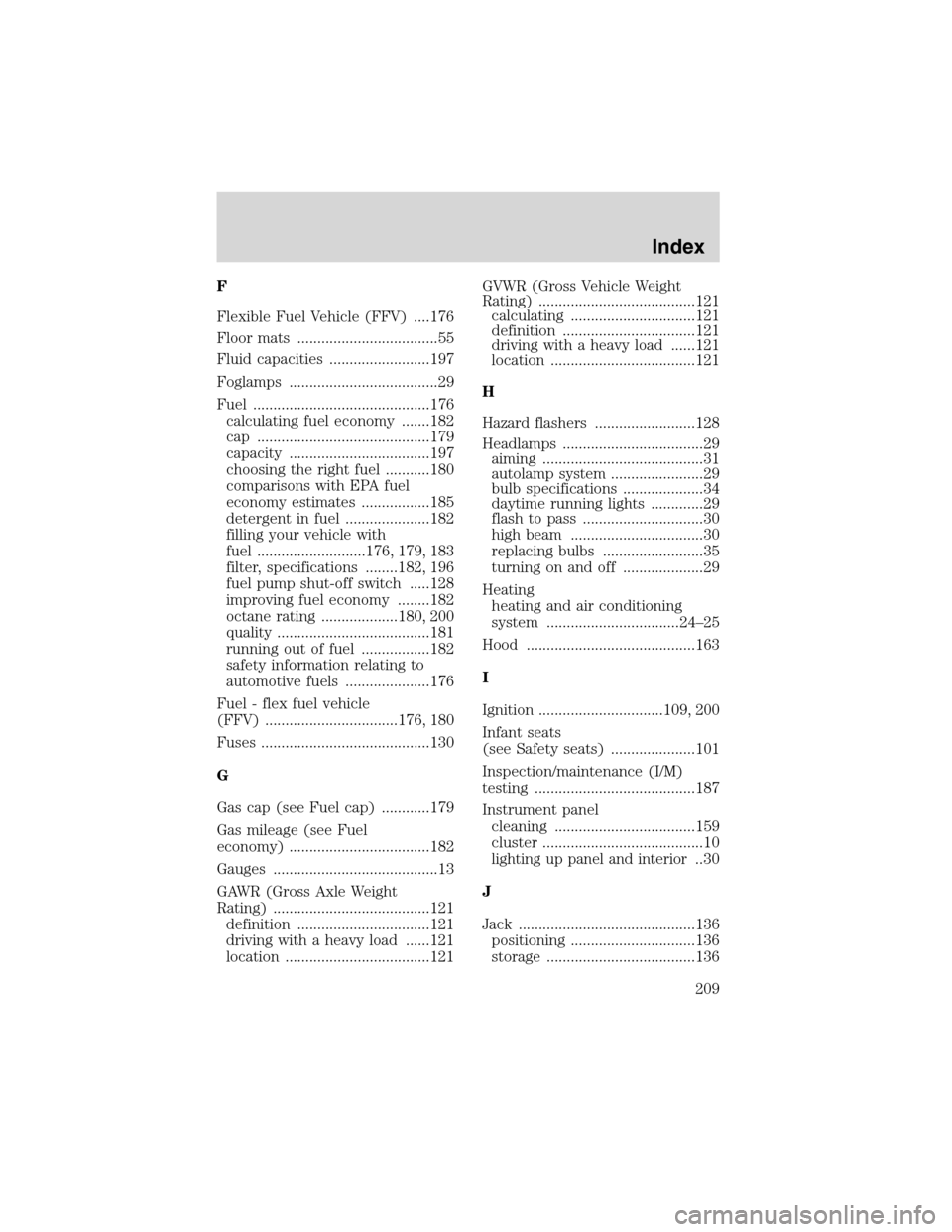air condition Mercury Sable 2003 s User Guide
[x] Cancel search | Manufacturer: MERCURY, Model Year: 2003, Model line: Sable, Model: Mercury Sable 2003Pages: 216, PDF Size: 1.66 MB
Page 113 of 216

If you experience cold weather starting problems on (Ed85) ethanol, and
neither an alternative brand of (E
d85) ethanol nor an engine block
heater is available, adding unleaded gasoline to your tank will improve
cold starting performance. Your vehicle is designed to operate on (E
d85)
ethanol, unleaded gasoline alone, or any mixture of the two.
If the engine fails to start using the preceding instructions (flexible
fuel vehicles only)
1. Press and hold down the accelerator 1/3 to 1/2 way to floor, then
crank the engine.
2. When the engine starts, release the key, then gradually release the
accelerator pedal as the engine speeds up. If the engine still fails to start,
repeat Step 1.
Using the engine block heater (if equipped)
An engine block heater warms the engine coolant which aids in starting
and heater/defroster performance. Use of an engine block heater is
strongly recommended if you live in a region where temperatures reach
-23°C (-10°F) or below. For best results, plug the heater in at least
three hours before starting the vehicle. The heater can be plugged in the
night before starting the vehicle.
To reduce the risk of electrical shock, do not use your heater
with ungrounded electrical systems or two-pronged (cheater)
adapters.
Guarding against exhaust fumes
Carbon monoxide is present in exhaust fumes. Take precautions to avoid
its dangerous effects.
If you smell exhaust fumes inside your vehicle, have your dealer
inspect your vehicle immediately. Do not drive if you smell
exhaust fumes.
Important ventilating information
If the engine is idling while the vehicle is stopped for a long period of
time, open the windows at least 2.5 cm (one inch) or adjust the heating
or air conditioning to bring in fresh air.
Driving
113
Page 155 of 216

2. Four or more repair attempts are made on the same nonconformity (a
defect or condition that substantially impairs the use, value or safety of
the vehicle) OR
3. The vehicle is out of service for repair of nonconformities for a total of
more than 30 calendar days (not necessarily all at one time)
In the case of 1 or 2 above, the consumer must also notify the
manufacturer of the need for the repair of the nonconformity at the
following address:
Ford Motor Company
16800 Executive Plaza Drive
Mail Drop 3NE-B
Dearborn, MI 48126
REPORTING SAFETY DEFECTS (U.S. ONLY)
If you believe that your vehicle has
a defect which could cause a crash
or could cause injury or death, you
should immediately inform the National Highway Traffic Safety
Administration (NHTSA) in addition to notifying Ford Motor Company.
If NHTSA receives similar complaints, it may open an investigation, and
if it finds that a safety defect exists in a group of vehicles, it may order a
recall and remedy campaign. However, NHTSA cannot become involved
in individual problems between you, your dealer, or Ford Motor
Company.
To contact NHTSA, you may either call the Auto Safety Hotline toll-free
at 1–800–424–9393 (or 366–0123 in the Washington D.C. area) or write
to:
NHTSA
U.S. Department of Transportation
Washington, D.C. 20590
You can also obtain other information about motor vehicle safety from
the Hotline.
Customer Assistance
155
Page 160 of 216

INTERIOR
For fabric, carpets, cloth seats, safety belts and seats equipped with side
air bags:
•Remove dust and loose dirt with a vacuum cleaner.
•Remove light stains and soil with Ford Extra Strength Upholstery
Cleaner (E8AZ-19523–AA).
•If grease or tar is present on the material, spot-clean the area first
with Motorcraft Spot and Stain Remover (ZC-14).
•Never saturate the seat covers with cleaning solution.
•Do not use household cleaning products or glass cleaners, which can
stain and discolor the fabric and affect the flame retardant abilities of
the seat materials.
Do not use cleaning solvents, bleach or dye on the vehicle’s
safety belts, as these actions may weaken the belt webbing.
Do not use chemical solvents or strong detergents when cleaning
the seat-mounted side air bag. Such products could contaminate
the side air bag system and affect performance of the side air bag in a
collision.
LEATHER SEATS (IF EQUIPPED)
Your leather seating surfaces have a clear, protective coating over the
leather.
•To clean, use a soft cloth with Motorcraft Deluxe Leather and Vinyl
Cleaner (ZC-11–A). Dry the area with a soft cloth.
•To help maintain its resiliency and color, use the Motorcraft Deluxe
Leather Care Kit (ZC-11–D), available from your authorized dealer.
•Do not use household cleaning products, alcohol solutions, solvents or
cleaners intended for rubber, vinyl and plastics, or oil/petroleum-based
leather conditioners. These products may cause premature wearing of
the clear, protective coating.
UNDERBODY
Flush the complete underside of your vehicle frequently. Keep body and
door drain holes free from packed dirt.
INTERIOR TRIM
•Clean the interior trim areas with a damp cloth, then dry by wiping
with a dry, soft, clean cloth.
•
Do not use household or glass cleaners as these may damage the finish.
Cleaning
160
Page 180 of 216

If you must replace the fuel filler cap, replace it with a fuel filler
cap that is designed for your vehicle. The customer warranty may
be void for any damage to the fuel tank or fuel system if the
correct genuine Ford or Motorcraft fuel filler cap is not used.
The fuel system may be under pressure. If the fuel filler cap is
venting vapor or if you hear a hissing sound, wait until it stops
before completely removing the fuel filler cap. Otherwise, fuel may
spray out and injure you or others.
If you do not use the proper fuel filler cap, excessive pressure or
vacuum in the fuel tank may damage the fuel system or cause
the fuel cap to disengage in a collision, which may result in possible
personal injury.
Choosing the right fuel
Use only UNLEADED FUEL. The use of leaded fuel is prohibited by law
and could damage your vehicle.
If your vehicle is a flexible fuel vehicle (FFV), use only UNLEADED
FUEL and (E85) ETHANOL. The use of leaded fuel is prohibited by law
and could damage your vehicle.
Do not use fuel containing methanol. It can damage critical fuel system
components.
Your vehicle was not designed to use fuel or fuel additives with metallic
compounds, including manganese-based compounds containing MMT.
Repairs to correct the effects of using a fuel for which your vehicle was
not designed may not be covered by your warranty.
Octane recommendations
Do not be concerned if your engine
sometimes knocks lightly. However,
if it knocks heavily under most
driving conditions while you are
using fuel with the recommended
octane rating, see your dealer or a qualified service technician to prevent
any engine damage.
Unleaded Gasoline engines
Your vehicle is designed to use“Regular”unleaded gasoline with an
(R+M)/2 octane rating of 87. We do not recommend the use of gasolines
labeled as“Regular”that are sold with octane ratings of 86 or lower in
high altitude areas.
87(R+M)/2 METHOD
Maintenance and Specifications
180
Page 184 of 216

3. After at least three to five tank fill-ups, fill the fuel tank and record
the current odometer reading.
4. Subtract your initial odometer reading from the current odometer
reading.
5. Follow one of the simple calculations in order to determine fuel
economy:
Calculation 1:Multiply liters used by 100, then divide by total
kilometers traveled.
Calculation 2:Divide total miles traveled by total gallons used.
Keep a record for at least one month and record the type of driving (city
or highway). This will provide an accurate estimate of the vehicle’s fuel
economy under current driving conditions. Additionally, keeping records
during summer and winter will show how temperature impacts fuel
economy. In general, lower temperatures give lower fuel economy.
Driving style—good driving and fuel economy habits
Give consideration to the lists that follow and you may be able to change
a number of variables and improve your fuel economy.
Habits
•Smooth, moderate operation can yield up to 10% savings in fuel.
•Steady speeds without stopping will usually give the best fuel
economy.
•Idling for long periods of time (greater than one minute) may waste
fuel.
•Anticipate stopping; slowing down may eliminate the need to stop.
•Sudden or hard accelerations may reduce fuel economy.
•Slow down gradually.
•Driving at reasonable speeds (traveling at 88 km/h [55 mph] uses 15%
less fuel than traveling at 105 km/h [65 mph]).
•Revving the engine before turning it off may reduce fuel economy.
•Using the air conditioner or defroster may reduce fuel economy.
•You may want to turn off the speed control in hilly terrain if
unnecessary shifting between third and fourth gear occurs.
Unnecessary shifting of this type could result in reduced fuel
economy.
•Warming up a vehicle on cold mornings is not required and may
reduce fuel economy.
Maintenance and Specifications
184
Page 207 of 216

A
Accessory delay ..........................48
Air bag supplemental restraint
system ..............................91–92, 95
and child safety seats ..............94
description ..........................92, 95
disposal ......................................97
driver air bag ................92, 94, 96
indicator light ...........................95
operation .......................92, 94, 96
passenger air bag .........92, 94, 96
side air bag ................................95
Air cleaner filter .......................196
Air conditioning ..........................25
Antifreeze (see Engine
coolant) .....................................172
Anti-lock brake system
(see Brakes) ..............................114
Anti-theft system ........................71
arming the system ....................71
disarming a triggered system ..72
Audio system (see Radio) ...16, 18
Automatic transaxle
fluid, adding ............................190
fluid, checking ........................190
fluid, refill capacities ..............197
fluid, specification ..................200
Automatic transmission
driving an automatic
overdrive .................................119
Auxiliary power point .................47
Axle
lubricant specifications ..........198
B
Battery .......................................170acid, treating emergencies .....170
jumping a disabled battery ....140
maintenance-free ....................170
replacement, specifications ...196
servicing ..................................170
BeltMinder ...................................87
Brakes ........................................114
anti-lock ...................................114
anti-lock brake system (ABS)
warning light ...........................114
fluid, checking and adding ....189
fluid, refill capacities ..............197
fluid, specifications .........198, 200
lubricant specifications ..198, 200
parking ....................................115
shift interlock ..........................117
Bulbs ............................................34
C
Capacities for refilling fluids ....197
Cargo area shade ........................58
Cargo cover .................................57
Cargo net .....................................57
CD changer .................................20
CD-single premium ...............16, 18
Cell phone use ............................55
Certification Label ....................202
Changing a tire .........................136
Child safety restraints ................98
child safety belts ......................98
Child safety seats ......................101
attaching with tether straps ..105
in front seat ............................102
in rear seat ......................102, 105
Cleaning your vehicle
engine compartment ..............157
Index
Index
207
Page 208 of 216

instrument panel ....................159
interior .............................159–160
interior trim ............................160
plastic parts ............................158
washing ....................................156
waxing .....................................156
wheels ......................................157
wiper blades ............................159
Climate control (see Air
conditioning or Heating) ............25
Compass, electronic ....................49
calibration .................................50
set zone adjustment .................49
Console ........................................54
Controls
power seat .................................75
Coolant
checking and adding ..............172
refill capacities ................175, 197
specifications ..................198, 200
Cruise control (see Speed
control) ........................................51
Customer Assistance ................127
Ford accessories for your
vehicle .....................................161
Ford Extended Service
Plan ..........................................149
Getting assistance outside the
U.S. and Canada .....................153
Getting roadside assistance ...127
Getting the service you need 147
Ordering additional owner’s
literature .................................154
The Dispute Settlement
Board .......................................149
Utilizing the
Mediation/Arbitration
Program ...................................152D
Daytime running lamps
(see Lamps) ................................29
Defrost
rear window ..............................28
Dipstick
automatic transmission fluid .190
engine oil .................................167
Doors
lubricant specifications ..........198
Driving under special
conditions ..................................120
through water .........................121
E
Emergencies, roadside
jump-starting ..........................140
Emergency Flashers .................128
Emission control system ..........186
Engine ........................................200
cleaning ...................................157
coolant .....................................172
idle speed control ...................170
lubrication specifications ......198,
200
refill capacities ........................197
service points ..................164–165
starting after a collision .........128
Engine block heater .................113
Engine oil ..................................167
checking and adding ..............167
dipstick ....................................167
filter, specifications ........169, 196
recommendations ...................169
refill capacities ........................197
specifications ..................198, 200
Exhaust fumes ..........................113
Index
208
Page 209 of 216

F
Flexible Fuel Vehicle (FFV) ....176
Floor mats ...................................55
Fluid capacities .........................197
Foglamps .....................................29
Fuel ............................................176
calculating fuel economy .......182
cap ...........................................179
capacity ...................................197
choosing the right fuel ...........180
comparisons with EPA fuel
economy estimates .................185
detergent in fuel .....................182
filling your vehicle with
fuel ...........................176, 179, 183
filter, specifications ........182, 196
fuel pump shut-off switch .....128
improving fuel economy ........182
octane rating ...................180, 200
quality ......................................181
running out of fuel .................182
safety information relating to
automotive fuels .....................176
Fuel - flex fuel vehicle
(FFV) .................................176, 180
Fuses ..........................................130
G
Gas cap (see Fuel cap) ............179
Gas mileage (see Fuel
economy) ...................................182
Gauges .........................................13
GAWR (Gross Axle Weight
Rating) .......................................121
definition .................................121
driving with a heavy load ......121
location ....................................121GVWR (Gross Vehicle Weight
Rating) .......................................121
calculating ...............................121
definition .................................121
driving with a heavy load ......121
location ....................................121
H
Hazard flashers .........................128
Headlamps ...................................29
aiming ........................................31
autolamp system .......................29
bulb specifications ....................34
daytime running lights .............29
flash to pass ..............................30
high beam .................................30
replacing bulbs .........................35
turning on and off ....................29
Heating
heating and air conditioning
system .................................24–25
Hood ..........................................163
I
Ignition ...............................109, 200
Infant seats
(see Safety seats) .....................101
Inspection/maintenance (I/M)
testing ........................................187
Instrument panel
cleaning ...................................159
cluster ........................................10
lighting up panel and interior..30
J
Jack ............................................136
positioning ...............................136
storage .....................................136
Index
209